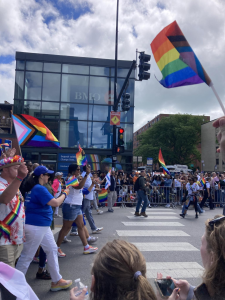Pay the Players: NCAA makes millions off of broke college athletes
March 27, 2018
With millions of people across the U.S tuning in for March Madness, the National Collegiate Athletic Association (NCAA) will pull in a big profit and keep most of the revenue from their student-athletes who put in the most work.
NCAA covers a lot of student-athlete expenses but should also pay their players as well. NCAA pushes the “students first, athletes second” idea. This is great because knowledge is power, but in America, so is having money.
USA Today has reported that Mark Emmert, the current NCAA president, made $1.7 million in 2011, $1.8 million in 2013 and $1.9 million in 2015. Every two years Emmert seems to make more money than before, which means the money is there to pay the players.
NCAA does provide for their student-athletes. For starters, most student-athletes will receive a scholarship(s) which covers tuition, textbooks, dormitory housing, meal plans and sport-related costs. The NCAA website says, “NCAA schools award more than $3.3 billion in athletic scholarships every year to more than 150,000 student-athletes.”
NCAA schools also offer student-athletes “state-of-the-art technology, tutoring, and access to academic advisors.”
Scholarships offered to student-athletes also help pay for school and with the average tuition for a U.S. public college at $25,290 per year and a U.S. private college at $50,900 per year, every penny counts. Scholarships and laptops are wonderful; regular college students dream of getting those but the truth is that academic and athletic scholarships are not the same thing as having money in the bank.
According to the former University of Maine student-athletes, now sports blogger, entrepreneur and Huffington Post writer, Tyson Hartnett, “Even with any type of scholarship, college athletes are typically dead broke. But how much do the top NCAA executives make? About $1 million per year.”
The NCAA also places their athletes on high-intensity schedules where they are required to balance schoolwork along with training. NCAA student-athletes in Division I have to meet certain standards, specifically to maintain a GPA of “2.3 or take a knee,” meaning they wouldn’t be allowed to play. This is a high standard considering that student-athletes can be on the road for up to two weeks at a time. Missing those classes and information can be detrimental to their grades.
The NCAA wants their athletes to be healthy in mind, body, and spirit, even funding an insurance policy that covers student-athletes up to $20 million in life insurance benefits, in case of a “catastrophic injury” while participating in the sport.
The fund is a nice touch, but what about the student-athletes that get “catastrophically injured” in a car accident and can no longer play their sport? Paying the student-athletes for their hard work can help pay any future medical bills that the fund will not cover.
The NCAA has partnered with medical organizations to try to provide the best medical care for their players. This includes the Concussion Assessment, Research and Education Consortium, collaboration with doctors to try to find ways to promote healthy hearts and cardiac problems, as well as spending more than $6 million a year on drug testing and education to promote a healthy, drug-free lifestyle for their athletes.
They are even tackling mental health. The Student-Athlete Leadership Forum and Career in Sports Forum offer training and educational programs to student-athletes to “enhance the well-being and personal development of college athletes.”
This is important. If the NCAA has millions of dollars to spend on physical and mental health, they have money to pay their players to put towards their emotional health. Spending time with family, friends, mentors or even animals at a shelter can positively boost emotional health. Paying athletes would allow them the opportunity to spend some of their limited time off from school and sports with their loved ones.
Everything that the NCAA does for their student-athletes probably is done with good-intention; however, at the end of the day, the players are the NCAA and university’s cash-cows. Without the players, there wouldn’t be any revenue to be made. The revenue doesn’t even go entirely into academics, so why not pay the players?
Depending on the team, college or university, the pay would obviously vary due to university success or having a larger fan base than others. Players do not need to be paid copious amounts of money like the professional players do but just enough to have spending money.
Being full-time athletes and students don’t allow for jobs, even a part-time job. Classes, practice, games, tournaments and muscle recovery takes a lot of time. Financial aid and scholarships don’t cover dinner with friends or a movie date with a significant other.
Also, not every student-athlete will go pro. If players were to be paid, they would have the opportunity to start investing in their future outside of college sports. If they choose to save their money, it can tie them over if they choose to pursue more advanced degrees after graduating.
NCAA, it’s time to pay the players.






Nancy Gurdak • Mar 28, 2018 at 9:37 pm
I think you pushed a button and I hope that the college’s and NCAA hear you and really consider your suggestion. Good luck